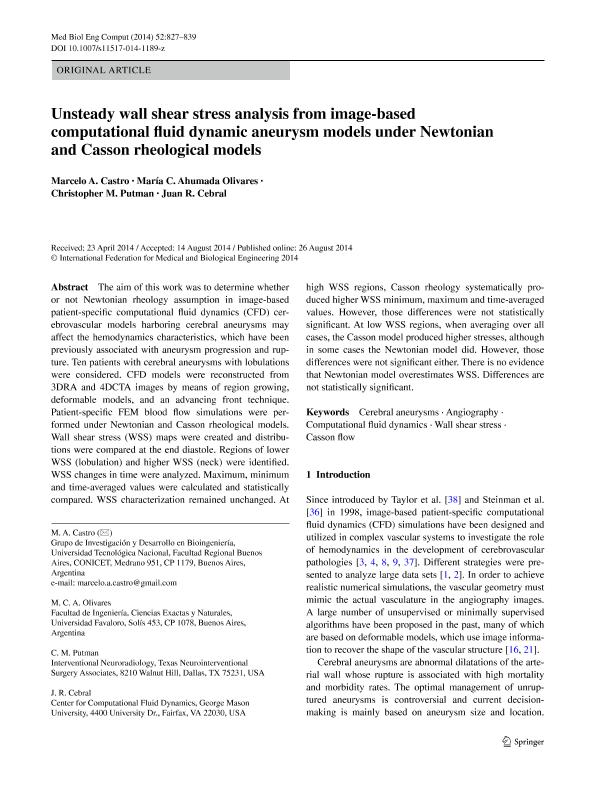Mostrar el registro sencillo del ítem
dc.contributor.author
Castro, Marcelo Adrian

dc.contributor.author
Olivares, María C. Ahumada
dc.contributor.author
Putman, Christopher M.
dc.contributor.author
Cebral, Juan R.
dc.date.available
2018-02-20T21:00:48Z
dc.date.issued
2014-09
dc.identifier.citation
Castro, Marcelo Adrian; Olivares, María C. Ahumada; Putman, Christopher M.; Cebral, Juan R.; Unsteady wall shear stress analysis from image-based computational fluid dynamic aneurysm models under Newtonian and Casson rheological models; Springer Heidelberg; Medical And Biological Engineering And Computing; 52; 10; 9-2014; 827-839
dc.identifier.issn
0140-0118
dc.identifier.uri
http://hdl.handle.net/11336/36852
dc.description.abstract
The aim of this work was to determine whether or not Newtonian rheology assumption in image-based patient-specific computational fluid dynamics (CFD) cerebrovascular models harboring cerebral aneurysms may affect the hemodynamics characteristics, which have been previously associated with aneurysm progression and rupture. Ten patients with cerebral aneurysms with lobulations were considered. CFD models were reconstructed from 3DRA and 4DCTA images by means of region growing, deformable models, and an advancing front technique. Patient-specific FEM blood flow simulations were performed under Newtonian and Casson rheological models. Wall shear stress (WSS) maps were created and distributions were compared at the end diastole. Regions of lower WSS (lobulation) and higher WSS (neck) were identified. WSS changes in time were analyzed. Maximum, minimum and time-averaged values were calculated and statistically compared. WSS characterization remained unchanged. At high WSS regions, Casson rheology systematically produced higher WSS minimum, maximum and time-averaged values. However, those differences were not statistically significant. At low WSS regions, when averaging over all cases, the Casson model produced higher stresses, although in some cases the Newtonian model did. However, those differences were not significant either. There is no evidence that Newtonian model overestimates WSS. Differences are not statistically significant.
dc.format
application/pdf
dc.language.iso
eng
dc.publisher
Springer Heidelberg

dc.rights
info:eu-repo/semantics/openAccess
dc.rights.uri
https://creativecommons.org/licenses/by-nc-sa/2.5/ar/
dc.subject
Angiography
dc.subject
Casson Flow
dc.subject
Cerebral Aneurysms
dc.subject
Computational Fluid Dynamics
dc.subject
Wall Shear Stress
dc.title
Unsteady wall shear stress analysis from image-based computational fluid dynamic aneurysm models under Newtonian and Casson rheological models
dc.type
info:eu-repo/semantics/article
dc.type
info:ar-repo/semantics/artículo
dc.type
info:eu-repo/semantics/publishedVersion
dc.date.updated
2018-02-09T19:50:28Z
dc.journal.volume
52
dc.journal.number
10
dc.journal.pagination
827-839
dc.journal.pais
Alemania

dc.journal.ciudad
HEIDELBERG
dc.description.fil
Fil: Castro, Marcelo Adrian. Universidad Tecnológica Nacional; Argentina. Consejo Nacional de Investigaciones Científicas y Técnicas; Argentina
dc.description.fil
Fil: Olivares, María C. Ahumada. Universidad Favaloro; Argentina
dc.description.fil
Fil: Putman, Christopher M.. Texas Neurointerventional Surgery Associates; Estados Unidos
dc.description.fil
Fil: Cebral, Juan R.. George Mason University; Estados Unidos
dc.journal.title
Medical And Biological Engineering And Computing

dc.relation.alternativeid
info:eu-repo/semantics/altIdentifier/url/https://link.springer.com/article/10.1007/s11517-014-1189-z
dc.relation.alternativeid
info:eu-repo/semantics/altIdentifier/doi/http://dx.doi.org/10.1007/s11517-014-1189-z
Archivos asociados
